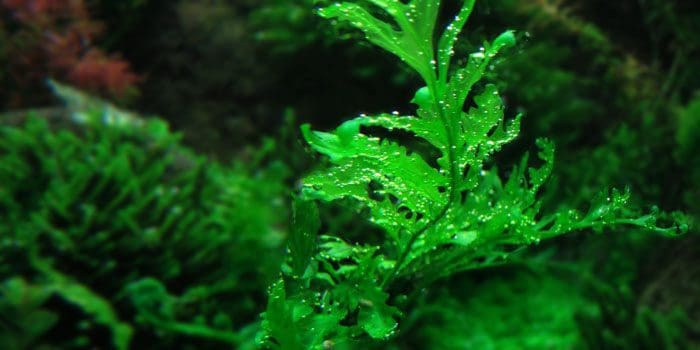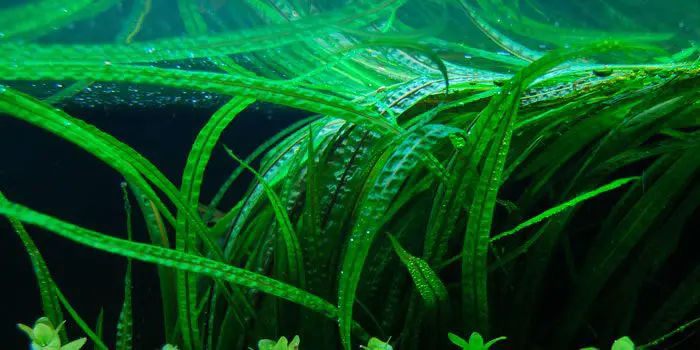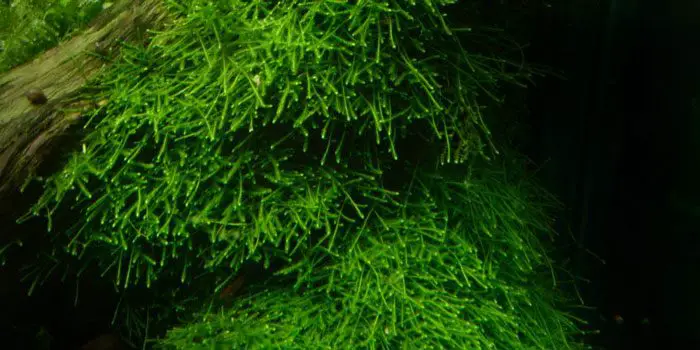For many beginners, it is not enough to have one basic aquarium setup with a particular plant as a set piece. The majority of beginners of this hobby want to have a variety of plants. In fact a list of plants that they can choose from – which makes their selection easier and smarting than just blowing money on plants that won’t survive.
There are many plant lists out there – high tech, low tech, for beginners, for professionals, etc. The thing is, you can easily get a list of plants that perfectly suits your needs. This particular list, however, aims to give you a list of plants that are best for beginners, low-tech plants so to speak. That means that they only need low light and occasional maintenance and they’re good to go.

Starting off with Bolbitis heudelotii or commonly known as African Water Fern. This guy is one of the easiest to grow in any tank. If you can grow Java moss, you can grow this! Having said that, African Water ferns sell for a pretty penny once it starts to grow pretty fast. Reproduction of this plant is from rhizomes on its leaves. You can let them just grow out or pull off the rhizome and replant on rock/driftwood for multiplication factors. With a low-tech planted tank, the Bolbitis Heudelotti will be a dark green color whereas in a high-tech planted tank – they are a translucent green to its leaves, shown in the picture above.
Side Note: The African Water Fern does take some time to accumulate to water conditions – so growth can be VERY slow in the beginning. Just give it time and place with a little water current and the plant will spring to life in your low-tech planted aquarium soon enough.

The Anubias Bateri or commonly known as the Anubias Broadleaf is a great filler plant for larger low-tech planted aquariums. They create hiding places for fauna and shrimp as well as perches for resting for fauna like catfish. Their leaves can grow up to 12 inches in length in the correct conditions. The rhizome will grow additional leaves and side-shoot but in a low-tech environment, it could take weeks or months to see growth from anubias’. This makes Anubias Bateri a great maintenance-free plant.
Side Note for all Rhizomes: Never bury a Rhizome into the substrate, they like to be tied to driftwood or rocks for root growth. Doing this may kill your Anubias Barteri’s Rhizome which means the plant will start to decay.

The Anubias Bateri v. Coffeefolia is one of those easy low-tech plants that will grow and always look beautiful. Just set it to a piece of driftwood or rock and watch it grow its leafs. The Anubias bateri v. coffeefolia has the unmistakable ripple leaf pattern and dark green hue to it. There is also a chance that the Anubias coffeefolia will flower underwater thinking it’s still in emersed form.
Make sure to never plant an anubias into the substrate; which will kill the Rhizome over time.

The Anubias Barteri v. Glabra is a bit different from the other anubias, with long-stemmed dark green leaf blades; which are longer compared to most anubias being wider. The Anubias Glabra is somewhat of an easy plant to take care of as long as your temperature range is around 71.6F to 82.4F

Looking for an easy maintenance low light plant for a nano-planted tank? Well, Anubias barteri v. Nana is what you’re looking for. With its leaves that range from 2-4 inches long, they are considered great for any nano tanks. Although one drawback to the Anubias barteri var. nana is the survivability of their leaves lasting longer than several years sometimes. This gives slow-growing algae like green spotted algae a chance to form on the anubias leaves. Make sure to always find a good planting place with lots of shade.

The Anubias Barteri v. nana golden is the last anubias I recommend for a low-tech planted tank. This is another nana just like the previous one but instead of those dark greens; the anubias barteri v. nana golden produces light greens to almost soft yellows in its leaf patterns. A new leaf will typically grow every month from the rhizome. Having said that, this means having it in a shaded area is a must because of long-term algae.
The Anubias Barteri v. nana golden is a great plant to contrast other darker colors in an aquascape or to make a focus point in a section.

The Bacopa Caroliniana is an awesome low-tech plant for any starter. One of the greatest things about it is it’s a universal plant, unlike anubias which needs shade. What I mean is it’s a slow grower in low-tech setups but it can grow pretty rapidly once Co2 and higher PAR light is added to the mix. Not to mention that the Bacopa Caroliniana resembles the shape of the lotus flower.
Bacopa Caroliniana stem can grow from 4 to 12 inches long in an aquarium. As well as you can always just propagate by cutting the stem into smaller portions and replanting.

Hydrocotyle leucocephala or commonly known as Brazilian Pennywort; is the jungle vine of the aquatic world. It is a great beginner plant for low-tech builds because it grows so quickly in almost any condition. Although having said that, you will be seeing yourself trimming a lot to keep it maintained and wrapping it around driftwood or hardscapes to give it an awesome effect.
Brazilian Pennywort is also a great nitrate sucker, if you have too much bioload, goldfish (which love to eat plants), or want to reduce your water changes because of too high of nitrates.

The Crypt Aponogetifolia is one of the big guy plants on the list. With its long crypt measuring over 40 inches in length, they are a huge plant (don’t let the photo fool you!) If you’re looking for a centerpiece plant or something that takes up a lot of space, The Crypt Aponogetifolia is probably an awesome choice. Especially if you want something easy to maintain and something slow growth.

Crypt Balansae is another big boy plant – with good low-tech lighting conditions; it can easily grow to be 24″ tall as well as have left an inch in width. Crypt Balansae is definitely a background plant but also loves to be in a bit of current; probably because its originates from flowing rivers and streams in southern Thailand.
If you’re looking for an overgrown lush feeling for an aquascape or dutch style aquascape – this might be your candidate. it’s pretty easy to maintain, just trim the Crypt Balansae’s runners every once in a while and replant if you like more dense growth.

Crypt Becketii is not a hugely talked about crypt in the planted tank world but it’s a nice hidden gem in my eyes. And guess what? it’s an easy plant for those low-tech tanks (actually it hates high intense lighting). It’s also a fan of hard water, so people that have volcanic water coming out of their pipes should be able to grow this plant with no problem! hehe. Typically crypts don’t like being moved around (much like any plants) and the crypt becket is like this especially. It experiences crypt melt if moved around too often; So make sure to pick a good spot and give it some months to grow.
If you want this guy to grow out faster, just supply it with some good substrate and Co2 – it will start sending runners in no time!

Crypt Spiralis is one of the most low-light aquarium dependent out of the twenty-three species I recommend. It is a tall slender crypt with nice ruffled leaves making it a unique background plant. Just make sure to keep it under the maximum light if in a low-lighted setup and either the nutrient-rich substrate or root tabs. Co2 injection can make this thing flourish and send out runners for awesome propagation.

Crypt Wendtii is one of the more popular crypts in the aquarium world, and guess what? it’s an awesome low-light aquarium plant as well! It’s a great foreground or midground plant for larger tanks or a background plant for nano aquariums. The Crypt Wendtii can handle both hard and soft water conditions, making it very versatile.
Crypts are deep rooters, so having rich nutrient substrates or adding root tabs is great for healthy root systems. Also if you are notorious digger fish like certain loaches and/or cichlids, These are great for them; because they are hard to uproot.

The famous Naja Grass or commonly known as Guppy Grass. It is so known for or actually named because it’s a safe haven feature for guppies looking to mate; as well as other species like red cherry shrimp. After the fry hatch, they have a place to hide and graze on micro-organisms while not worrying about predators. Guppy Grass also grows quickly, sucking up all those excess nitrates and keeping the planted tank cleaner.
Oh by the way, Guppy Grass is probably one of the easiest to grow out. just throw it in the tank (doesn’t even need to be planted) and it will grow. Maintenance trimming is required and make sure no fry is being pulled if you are trying to breed.

Hornwort is another breeder’s favorite. With adequate lighting – hornwort will become a dense forest of needle leaves giving fry refuge to hide from predators while they forage. Hornwort can be grown either by being planted or just floating it. In a low light setting, Hornwort will still grow perfectly fine but will be less compact in growth and less maintenance in trimming. It’s an awesome nitrate sucker as well if you have high nitrates in your aquarium.

Java Fern is one of the all-time favorites. With its long broad leaves and slow-growing rhizomes; it is easy to maintain and loved by almost all fauna. Oto’s will lounge on the java fern’s leaves sucking algae all day long while other fish like Harlequin Rasboras will try to use the underside as a place to lay their eggs while breeding. In a low-light planted tank, it might take months to see any growth. Whereas in a high-tech planted tank, it will grow a new leaf every week of the rhizome as well as have brown seeds on the underside of its leaves. These are in fact another complete root system growing off the leaf structure – give it a week or so and just pluck them off and replant!

Of course, there is moss that is low in demand of light and nutrients and the famous one is Java Moss! It grows in almost all conditions and is used in shipping shrimp or nano fauna all around the world – giving them something to cling onto or hide in. Java Moss is also used in a refuge for fry and micro-organisms if your trying to develop a culture for predator fish. All this plus it just looks good, the dense green foliage that will slowly grow out. It’s pretty simple to maintain and in high-tech planted tanks, it even has a more compact deeper green to it.
This is one of the all-time favorites mosses for any beginner – you would have to actually nuke your tank to even try to kill this time to moss. A great start for a beginner green thumb

Bacopa Monnieri or more commonly known as Moneywort is an undemanding stem plant for low-light aquariums. Moneywort will grow vertically till it reaches the surface. If the light isn’t adequate enough, leaves on the lower stem will start to rot off. Moneywort is still a great all-around plant for beginners and advanced hobbyists. Propagation is achieved by trimming the stem and replanting it into the substrate. With hi-tech builds, Moneywort will start to send out runners or shoots to self-propagate.

Narrow Leaf Java Fern is a pretty undemanding fern just like Java Fern but without the broad-leaf style. They are pretty faster growers in low-light planted tanks without Co2 – which it seems Fern’s don’t fancy too much. If you are the type looking to propagate Narrow Leaf Java Fern, just cut the rhizome in portions or hopefully with the right conditions – your narrow leaf Java ferns reproduce with spores and create brown bump spores on the underbelly of the leaf. These things are baby plantlets and can be de-attached or left on the leaf once grown out.

Pellia Liverwort is actually not a moss-like most people think. It doesn’t have organized parts like roots, stems, or leaves. Pellia actually has what is called Thallus; where propagation is done by cutting Thalli. So what’s so good about Pellia? it’s actually pretty simple liverwort. It needs very little demand and will propagate itself. Why it’s not a favorite by a lot of hobbyists because of its huge alien shape thallus. A good substitution form is its smaller form called mini-pella except it’s a bit more demanding with lights.

With hundreds of different varieties of Rotala, one of the more beautiful ones is Rotala Indica, and guess what? it’s an easy aquatic plant to get started with. The Rotala Indica does like a bit more light, so try to find a bright area that gives it. If you start to see lower leaves start to rot, then you will need to reposition the rotala indica, trim it down and replant it, or upgrade for more light so the bottom foliage gets enough lighting.

Who doesn’t know about Rotala rotundifolia? It’s one of the easiest Rotalas to take care of and it’s also not sold in a lot of aquarium stores; that means it’s valuable in aquatic communities looking to trade or if you looking for a quick buck! Rotala rotundifolia is such an awesome background plant; with its star pattern leaves and dark green stems – it really does stand out from the rest. It is an easy-to-grow plant with little light and nutrients; while its root system can become MASSIVE! Best of all, if you ever are looking to get red variants in your aquarium, something different from the green scheme – just Co2 + iron dosing and the Rotala Rotundifolia will grow so quickly, it turns bright pink from all the new growth.
It is definitely one of the first aquatic plants I’ve learned about and probably still one of my favorites for low-tech or high-tech aquariums.

Windelov Java Fern is last on our list of 23 easy-to-grow & low-light aquarium plants. It was founded by Holger Windelov of Tropica – one of the largest aquatic suppliers in the UK. The Windelov fern has distinct triple split edges on the end of its leaves creating a unique appearance. The Windelov Java Fern is really easy to take care of just like all the other ferns and barely needs any light. If you like something a bit bushier versus the other ferns but with all the same characteristics of Java Fern, then Windelov is probably a good choice for you.
Note that some of these plants, although able to thrive on low light configuration, can also grow well using high light configuration. Some of these plants, when exposed to high light, will only change in color intensity.






